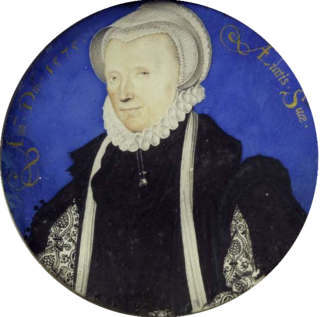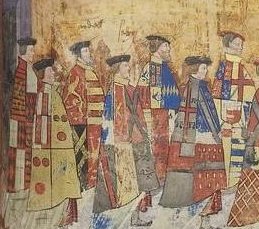
Catherine of Aragon was Queen of England as the first wife of King Henry VIII from their marriage on 11 June 1509 until its annulment on 23 May 1533. She was Princess of Wales while married to Henry's elder brother, Arthur, Prince of Wales, for a short period before his death.

Mary Tudor was an English princess who was briefly Queen of France as the third wife of King Louis XII. Louis was more than 30 years her senior. Mary was the fifth child of Henry VII of England and Elizabeth of York, and the youngest to survive infancy.

Margaret Plantagenet, Countess of Salisbury, was the only surviving daughter of George Plantagenet, Duke of Clarence and his wife Isabel Neville. As a result of Margaret's marriage to Richard Pole, she was also known as Margaret Pole. She was one of just two women in 16th-century England to be a peeress in her own right without a husband in the House of Lords.

Margaret Douglas, Countess of Lennox, was the daughter of the Scottish queen dowager Margaret Tudor and her second husband Archibald Douglas, 6th Earl of Angus, and thus the granddaughter of King Henry VII of England and the half-sister of King James V. She was the grandmother of King James VI and I.

Thomas Howard, 3rd Duke of Norfolk, was a prominent English politician and nobleman of the Tudor era. He was an uncle of two of the wives of King Henry VIII, Anne Boleyn and Catherine Howard, both of whom were beheaded, and played a major role in the machinations affecting these royal marriages. After falling from favour in 1546, he was stripped of his dukedom and imprisoned in the Tower of London, avoiding execution when Henry VIII died on 28 January 1547.

Charles Brandon, 1st Duke of Suffolk was an English military leader and courtier. Through his third wife, Mary Tudor, he was brother-in-law to King Henry VIII.

Elizabeth Blount, commonly known during her lifetime as Bessie Blount, was a mistress of Henry VIII of England.

In common parlance, the wives of Henry VIII were the six Queen consorts of King Henry VIII of England between 1509 and his death in 1547. In legal terms, Henry had only three wives, because three of his marriages were annulled by the Church of England. He was never granted an annulment by the Pope as he desired, for Catherine of Aragon, his first wife. Annulments declare that a true marriage never took place, unlike a divorce, in which a married couple end their union. Along with his six wives, Henry took several mistresses.

Frances Grey, Duchess of Suffolk, was an English noblewoman. She was the second child and eldest daughter of King Henry VIII's younger sister, Princess Mary, and Charles Brandon, 1st Duke of Suffolk. She was the mother of Lady Jane Grey, de facto Queen of England and Ireland for nine days, as well as Lady Katherine Grey and Lady Mary Grey.

Cecily of York, also known as Cecelia, was the third daughter of King Edward IV of England and his queen consort Elizabeth Woodville.

Henry Courtenay, 1st Marquess of Exeter, 2nd Earl of Devon, KG, PC, feudal baron of Okehampton, feudal baron of Plympton, of Tiverton Castle, Okehampton Castle and Colcombe Castle all in Devon, was a grandson of King Edward IV, nephew of the queen consort, Elizabeth of York and a first cousin of King Henry VIII. Henry Courtenay was a close friend of Henry VIII, having "been brought up of a child with his grace in his chamber".

Sir Thomas Parr of Kendal in Westmorland, England, was a courtier and is best known as the father of Queen Catherine Parr, the sixth and final wife of King Henry VIII.

John Hussey, 1st Baron Hussey of Sleaford was Chief Butler of England from 1521 until his death. He was a member of the House of Lords, and a Chamberlain to King Henry VIII's daughter, Mary I of England.
Elizabeth Holland, commonly known as Bess Holland, was an English courtier. She was the mistress of Thomas Howard, 3rd Duke of Norfolk and maid-of-honour to his niece, Anne Boleyn, the second wife of Henry VIII of England.

Mary Boleyn, also known as Lady Mary, was the sister of English queen consort Anne Boleyn, whose family enjoyed considerable influence during the reign of King Henry VIII.

Elizabeth Tilney, Countess of Surrey was an English heiress who became the first wife of Thomas Howard, 2nd Duke of Norfolk. She served successively as a lady-in-waiting to two Queen consorts, namely Elizabeth Woodville, wife of King Edward IV, and later as Lady of the Bedchamber to that Queen's daughter, Elizabeth of York, the wife of King Henry VII. She stood as joint godmother to Princess Margaret Tudor at her baptism.
Sir Edward Bayntun, of Bromham, Wiltshire, was a gentleman at the court of Henry VIII of England. He was vice-chamberlain to Anne Boleyn, the King's second wife, and was the brother-in-law of Queen Catherine Howard, Henry VIII's fifth wife.
Mary Scrope was an English courtier. She was the granddaughter of Henry Scrope, 4th Baron Scrope of Bolton, and the sister of Elizabeth Scrope, wife of John de Vere, 13th Earl of Oxford, and Margaret Scrope, wife of Edmund de la Pole, 3rd Duke of Suffolk. She is said to have been in the service at court of King Henry VIII's first four wives. As the wife of Sir William Kingston, Constable of the Tower of London, she was in attendance on Anne Boleyn during the Queen's brief imprisonment in the Tower in May 1536, and both she and her husband were among those who walked with the Queen to the scaffold. By her first husband, Edward Jerningham, she was the mother of Sir Henry Jerningham, whose support helped to place Queen Mary I on the throne of England in 1553, and who became one of Queen Mary's most favoured courtiers.
Isabel Leigh, Lady Stumpe was a lady-in-waiting during the reign of her younger half-sister, Catherine Howard, fifth wife and Queen Consort to Henry VIII.
Sir Edward Burgh was the eldest son and heir to Sir Thomas Burgh, 1st Baron Burgh and his wife Agnes Tyrwhit. He is known for being the first husband of Catherine Parr, later queen of England. 18th-century historians have mistaken him for his grandfather, the elderly, Edward Burgh, 2nd Baron Burgh.














